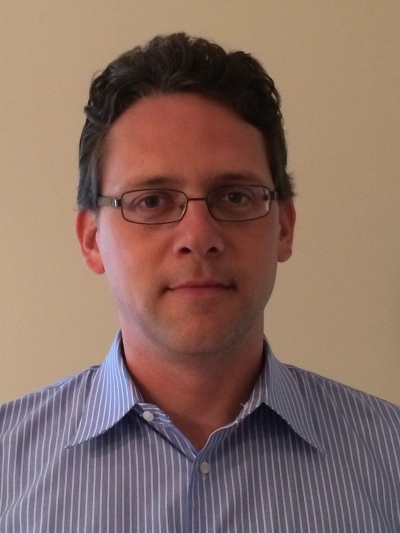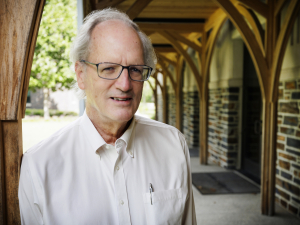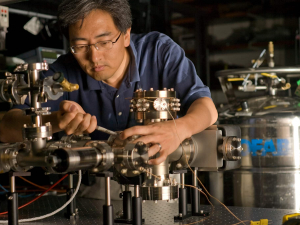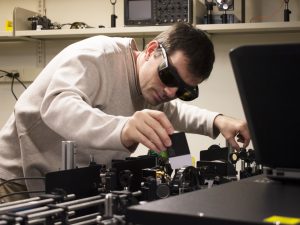Bill Brown: Finding System Solutions

“I like to build things that don’t exist,” says entrepreneur William J. “Bill” Brown, who earned his PhD in physics from Duke in 1999. “In physics, I did tabletop experiments where I had to do it all—optics, electronics, mechanics, software, and theory. Now, I view a company as something new I’m building.”
When Brown began his graduate studies at Duke, he was planning a career in academia. Halfway through, he realized that wasn’t the path for him. He was more drawn to the idea of entrepreneurship. “I’ve always been reasonably comfortable with that kind of risk,” he says. In fact, he cofounded his first start-up in 8th grade with his father, a computer science professor. They wrote a program to teach middle-school math and sold it to a couple of schools.
Before graduating, he took a class at the Fuqua School of Business. Although he didn’t do an internship, it’s something he recommends to others.“Any graduate student I talk to,” Brown says, “I encourage them to at least think about an internship with a commercial entity to get some perspective, some experience, and to start to network.”
Since graduating from Duke, Brown has been on the ground floor of several companies that use optics or photonics to create technological solutions to issues related to medical imaging and diagnostics.
Even though all the companies he’s been involved in revolve around photonics, Brown says, “I don’t do a whole lot of science on a day-to-day basis. I do a lot of systems-level engineering. One of the most powerful skills I bring to the table is that I can sit in the middle of a group of engineers and keep them all pointed in the same direction.”
One of the companies he co-founded, Bioptigen, was sold in June 2015 to Leica Microsystems. (See related story here.) Brown co-founded Bioptigen with Joseph Izatt, the Michael J. Fitzpatrick Professor of Engineering, and CEO Eric Buckland. Izatt says, “Bill had a very strong background in physics and optics and brought deep understanding as well as great hands-on engineering skills to the company.”
Bioptigen manufactures medical instruments that use optical coherence tomography (OCT) to produce images of tiny structures in the eye, skin, heart, and other organs. Unlike MRI, CT, or ultrasound imaging technology, OCT has a resolution on the cellular level, allowing doctors and researchers to see more clearly than ever before into structures such as the layers of the retina.
OCT has been in use since the 1990s, but the Duke team—including Cynthia Toth, the Joseph A. C. Wadsworth Professor of Ophthalmology—made improvements to make it faster, more robust, and easier to use. Before leaving Bioptigen in 2006, Brown brought in significant early funding through federal Small Business Innovation Research (SBIR) grants.
Currently, Brown is working on two early stage companies with Adam Wax, the Theodore Kennedy Professor of Biomedical Engineering at the Pratt School, who—like Brown—earned his PhD from Duke Physics in 1999. Wax says, “Bill’s most outstanding quality that he brings to a start-up is that he’s got a unique ability to take a technology and turn it into a product.”
Brown previously collaborated with Wax in founding Oncoscope, a start-up that developed and tested a machine to identify pre-cancerous cells in the esophagus using low-coherence interferometry (LCI) to measure the diameter of nuclei.
One of the two projects he’s working on with Wax now involves a faster and cheaper way to do complete blood counts (CBCs), which now take 2-3 days at the typical doctor’s office or about 90 minutes in a hospital. For this project, he’s secured Small Business Technology Transfer Program (STTR) money from the National Science Foundation.
As if his plate weren’t full enough, Brown is also consulting with 8 Rivers Capital at American Tobacco Campus on another new product idea.
“This is the first time in my career that I’ve had more than one viable idea in front of me at the same time,” he says. “The overall economy has gotten much better and the interest in innovation has come back. In the photonics space, there continue to be tremendous advances, particularly in components. People are building new devices, new lasers, new detectors. That drives what I can do on a system level.”
As for the future, Brown says, “Short term, I’ll turn something into another company. Longer term I would like to actually build something I can stay with for more than four years. I want to see one of these things all the way through from the start to some finish.” After a pause he adds, “The reality may be that I’m an early stage guy. The early stage is total chaos—that doesn’t scare me.”
Mary-Russell Roberson is a freelance science writer who lives in Durham.




